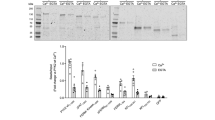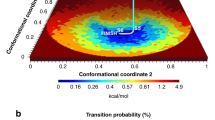Abstract
Many eukaryotic cellular and viral proteins have a covalently attached myristoyl group at the amino terminus. One such protein is recoverin, a calcium sensor in retinal rod cells, which controls the lifetime of photoexcited rhodopsin by inhibiting rhodopsin kinase1,2,3,4,5,6. Recoverin has a relative molecular mass of 23,000 (Mr 23K), and contains an amino-terminal myristoyl group (or related acyl group) and four EF hands7. The binding of two Ca2+ ions to recoverin leads to its translocation from the cytosol to the disc membrane8,9. In the Ca2+-free state, the myristoyl group is sequestered in a deep hydrophobic box, where it is clamped by multiple residues contributed by three of the EF hands10. We have used nuclear magnetic resonance to show that Ca2+ induces the unclamping and extrusion of the myristoyl group, enabling it to interact with a lipid bilayer membrane. The transition is also accompanied by a 45-degree rotation of the amino-terminal domain relative to the carboxy-terminal domain, and many hydrophobic residues are exposed. The conservation of the myristoyl binding site and two swivels in recoverin homologues from yeast to humans indicates that calcium–myristoyl switches are ancient devices for controlling calcium-sensitive processes.
This is a preview of subscription content, access via your institution
Access options
Subscribe to this journal
Receive 51 print issues and online access
$199.00 per year
only $3.90 per issue
Buy this article
- Purchase on Springer Link
- Instant access to full article PDF
Prices may be subject to local taxes which are calculated during checkout




Similar content being viewed by others
References
Dizhoor, A. M. et al. Recoverin: a calcium sensitive activator of retinal rod guanylate cyclase. Science 251, 915–918 (1991).
Hurley, J. B., Dizhoor, A. M., Ray, S. & Stryer, L. Recoverin's role: conclusion withdrawn. Science 260, 740 (1993).
Gray-Keller, M. P., Polans, A. S., Palczewski, K. & Detwiler, P. B. The effect of recoverin-like calcium-binding proteins on the photoresponse of retinal rods. Neuron 10, 523–531 (1993).
Kawamura, S., Hisatomi, O., Kayada, S., Tokunaga, F. & Kuo, C.-H. Recoverin has S-modulin activity in frog rods. J. Biol. Chem. 268, 14579–14582 (1993).
Chen, C. K., Inglese, J., Lefkowitz, R. J. & Hurley, J. B. Ca2+-dependent interaction of recoverin with rhodopsin kinase. J. Biol. Chem. 270, 18060–18066 (1995).
Klenchin, A. K., Calvert, P. D. & Bownds, M. D. Inhibition of rhodopsin kinase by recoverin. J. Biol. Chem. 270, 16147–16152 (1995).
Dizhoor, A. M. et al. The amino terminus of retinal recoverin is acylated by a small family of fatty acids. J. Biol. Chem. 267, 16033–16036 (1992).
Zozulya, S. & Stryer, L. Calcium-myristoyl protein switch. Proc. Natl Acad. Sci. USA 89, 11569–11573 (1992).
Dizhoor, A. M. et al. Role of acylated amino terminus of recoverin in Ca2+-dependent membrane interaction. Science 259, 829–832 (1993).
Tanaka, T., Ames, J. B., Harvey, T. S., Stryer, L. & Ikura, M. Sequestration of the membrane-targeting myristoyl group of recoverin in the Ca2+-free state. Nature 376, 444–447 (1995).
Kamps, M. P., Buss, J. E. & Sefton, B. M. Mutation of the amino-terminal glycine of p60src prevents both myristoylation and morphological transformation. Proc. Natl Acad. Sci. USA 82, 4625–4628 (1985).
Flaherty, K. M., Zozulya, S., Stryer, L. & McKay, D. B. Three-dimensional structure of recoverin, a calcium sensor in vision. Cell 75, 709–716 (1993).
Ames, J. B., Tanaka, T., Ikura, M. & Stryer, L. NMR evidence for Ca2+-induced extrusion of the myristoyl group of recoverin. J. Biol. Chem. 270, 30909–30913 (1995).
Hughes, R. E., Brzovic, P. S., Klevitt, R. E. & Hurley, J. B. Calcium-dependent solvation of the myristoyl group of recoverin. Biochemistry 34, 11410–11416 (1995).
Strynadka, N. C. & James, M. N. Crystal structures of the helix-loop-helix calcium-binding proteins. Annu. Rev. Biochem. 58, 951–998 (1989).
Ikura, M. Calcium binding and conformational response in EF-hand proteins. Trends Biochem. Sci. 21, 14–17 (1996).
Ames, J. B., Porumb, T., Tanaka, T., Ikura, M. & Stryer, L. Amino-terminal myristoylation induces cooperative calcium binding to recoverin. J. Biol. Chem. 270, 4526–4533 (1995).
Herzberg, O. & James, M. N. Refined crystal structure of troponin C from turkey skeletal muscle at 2.0 å resolution. J. Mol. Biol. 203, 761–779 (1988).
Kuno, T. et al. cDNA cloning of a neural visinin-like Ca2+-binding protein. Biochem. Biophys. Res. Commun. 184, 1219–1225 (1992).
Kobayashi, M., Takamatsu, K., Saitoh, S. & Noguchi, T. Molecular cloning of hippocalcin, a novel calcium-binding protein of the recoverin family. J. Biol. Chem. 268, 18898–18904 (1993).
Pongs, O. et al. Frequenin: a novel calcium-binding protein that modulates synaptic efficacy in the Drosophila nervous system. Neuron 11, 15–28 (1993).
De Castro, E. et al. Regulation of rhodopsin phosphorylation by a family of neuronal calcium sensors. Biochem. Biophys. Res. Commun. 216, 133–140 (1995).
Ames, J. B., Tanaka, T., Stryer, L. & Ikura, M. Secondary structure of myristoylated recoverin determined by three-dimensional heteronuclear NMR: Implications for the calcium-myristoyl switch. Biochemistry 33, 10743–10753 (1994).
Nilges, M., Gronenborn, A. M., Brunger, A. T. & Clore, G. M. Determination of three-dimensional structures of proteins by simulated annealing with interproton distance restraints. Protein Eng. 2, 27–38 (1988).
Brunger, A. T. X-PLOR Version 3.1: A System for X-ray Crystallography and NMR (Yale Univ. Press, New Haven, T, 1993).
Babu, Y. S., Bugg, C. E. & Cook, W. J. Structure of calmodulin refined at 2.2 å resolution. J. Mol. Biol. 204, 191–199 (1988).
Ferrin, T., Huang, C., Jarvis, L. & Langridge, R. The MIDAS display system. J. Mol. Graph. 6, 13–27 (1988).
Kraulis, P. J. Molscript: a program to produce both detailed and schematic plots of protein structures. J. Appl. Crystallogr. 24, 946–950 (1991).
Bacon, D. J. & Anderson, W. F. Afast algorithm for rendering space-filling molecule pictures. J. Mol. Graph. 6, 219–220 (1988).
Acknowledgements
We thank G. Gokel for help with the synthesis of 13-oxatetradecanoic acid; L. Kay for help with NMR experiments; and F. Delaglio and D. Garrett for computer software for NMR data processing and analysis. This work was supported by grants to L.S. and J.G. from the NIH, and to M.I. from the Medical Research Council of Canada. J.B.A. was supported by an NIH post-doctoral fellowship. M.I. is a Howard Hughes Medical Institute international research scholar.
Author information
Authors and Affiliations
Corresponding author
Rights and permissions
About this article
Cite this article
Ames, J., Ishima, R., Tanaka, T. et al. Molecular mechanics of calcium–myristoyl switches. Nature 389, 198–202 (1997). https://doi.org/10.1038/38310
Received:
Accepted:
Issue Date:
DOI: https://doi.org/10.1038/38310
This article is cited by
-
Mitochondrial Fus1/Tusc2 and cellular Ca2+ homeostasis: tumor suppressor, anti-inflammatory and anti-aging implications
Cancer Gene Therapy (2022)
-
Biochemistry and physiology of zebrafish photoreceptors
Pflügers Archiv - European Journal of Physiology (2021)
-
Regulation of retinal membrane guanylyl cyclase (RetGC) by negative calcium feedback and RD3 protein
Pflügers Archiv - European Journal of Physiology (2021)
-
Disorder in a two-domain neuronal Ca2+-binding protein regulates domain stability and dynamics using ligand mimicry
Cellular and Molecular Life Sciences (2021)
-
Hippocalcin Distribution between the Cytosol and Plasma Membrane of Living Cells
Neurophysiology (2020)
Comments
By submitting a comment you agree to abide by our Terms and Community Guidelines. If you find something abusive or that does not comply with our terms or guidelines please flag it as inappropriate.



